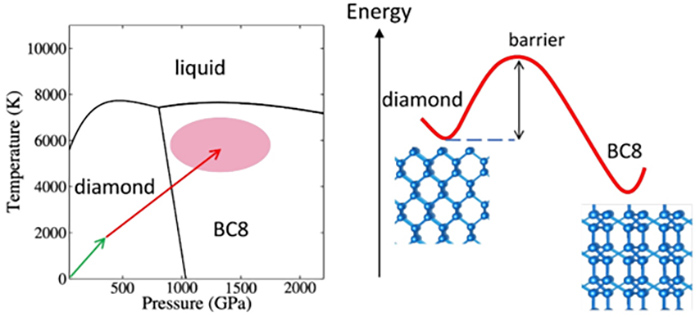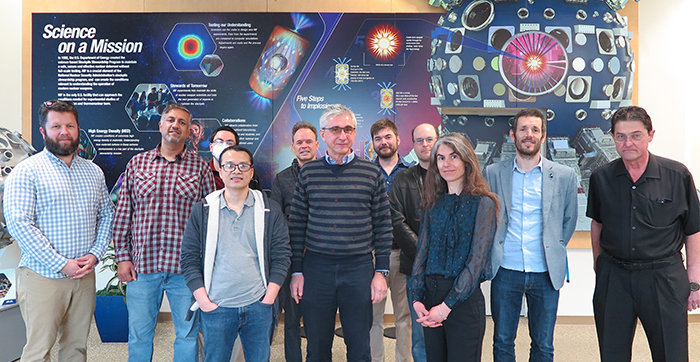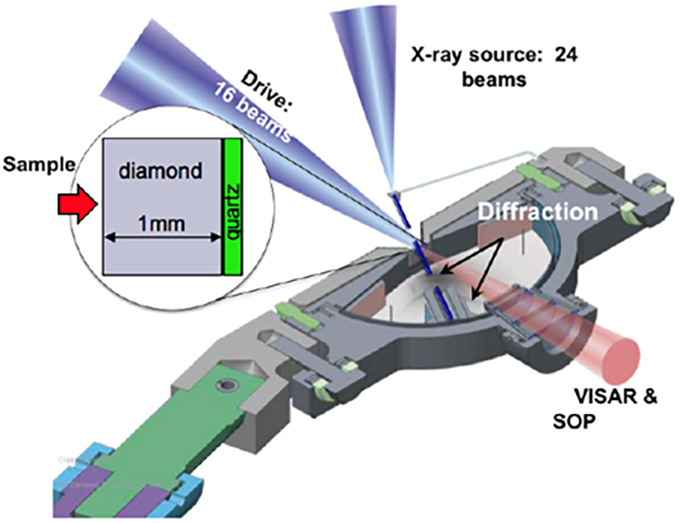Beyond Diamond: Seeking
An Elusive Phase of Carbon
April 13, 2023
Carbon, an essential ingredient of life on Earth, is a shapeshifter. The extreme strength of carbon-carbon bonds enables the material to take on many different structural forms, called phases or allotropes, at ambient temperatures and pressures.
Examples range from the familiar, such as graphite and diamond, to more exotic forms like zero-dimensional fullerenes, 1-D nanotubes, 2-D graphene, and the 3-D Lonsdaleite found in meteorites. The high-pressure carbon phases beyond diamond are elusive, though, making their discovery a challenge.
For example, the first “superdense” post-diamond carbon phase, called BC8, exists only in theory. Research dating back to the 1980s suggests that under extreme pressure, diamond can transform to BC8, which has even higher compressive strength and thermal conductivity than diamond.
 Theoretical calculations predict that several thermodynamically stable carbon crystalline phases exist at ultrahigh pressures. One of them, BC8, is thought to have similar strong tetrahedral atomic bonding as diamond. The synthesis of BC8 is extremely difficult due to the very high energy barrier separating the diamond precursor and BC8 phases. A new NIF Discovery Science campaign will test predictions that the barrier can be overcome by tailoring higher-temperature compression pathways than in previous experiments.
Theoretical calculations predict that several thermodynamically stable carbon crystalline phases exist at ultrahigh pressures. One of them, BC8, is thought to have similar strong tetrahedral atomic bonding as diamond. The synthesis of BC8 is extremely difficult due to the very high energy barrier separating the diamond precursor and BC8 phases. A new NIF Discovery Science campaign will test predictions that the barrier can be overcome by tailoring higher-temperature compression pathways than in previous experiments. Along with its many industrial applications, diamond is used in NIF target capsules due to its high density, which results in higher efficiency and more absorbed energy in NIF implosions compared to the plastic capsules used in early NIF experiments.
If post-diamond phases of carbon were confirmed, the finding would be a material science breakthrough and could have important implications for NIF inertial confinement fusion experiments, for future technologies, and for modeling the carbon-rich interiors of planets like Uranus, Neptune, and some exoplanets.
“These are extremely challenging experiments that we can only do at NIF.”
—Physicist Ivan Oleynik
“BC8 is thought to be as hard as or harder than diamond and it may be even tougher than diamond, with less of a tendency to break apart under stress,” said LLNL physicist Jon Eggert. “If the BC8 phase is metastable—not inclined to revert to diamond or graphite at standard temperature and pressure—and can be recovered, it holds potential for enormous technological impact. The goal is to get a material you can carry around.”
But confirming those theoretical predictions has been anything but easy. Researchers at NIF and other facilities have been trying for years to synthesize BC8.
In 2009, an experiment at Sandia National Laboratories’ pulse-power Z machine hinted at the existence of BC8 but did not observe the atomic structure. In 2015, a team of scientists led by Eggert, LLNL staff scientist Amy Lazicki, and Justin Wark of the University of Oxford in the UK launched a NIF Discovery Science (DS) campaign to use x-ray diffraction, which determines the crystal structure of solids, to look for evidence of a phase transition from diamond to BC8.
High Energy Barriers
That campaign used NIF to ramp-compress carbon samples to 20 megabars (million atmospheres), more than five times the pressure at Earth’s center. “We found that solid carbon retains the diamond structure far beyond its regime of predicted stability,” the researchers reported in the journal Nature in 2021.
“The results confirm predictions that the strength of the tetrahedral molecular orbital bonds in diamond persist under enormous pressure,” said Lazicki, first author of the Nature paper, “confirming the existence of a large energy barrier that hinders conversion to more-stable high-pressure post-diamond phases” such as BC8.
While that study was unable to demonstrate BC8, another team has taken up the challenge using a different strategy. Physicist Ivan Oleynik of the University of South Florida (USF) and LLNL physicist Marius Millot are leading a new simulation-inspired DS campaign that seeks to surmount the large energy barrier separating the diamond and BC8 phases by simultaneously compressing and heating a diamond sample to very high temperatures, close to the diamond melting line.
The new approach uses tailored high-temperature compression pathways and thicker targets to achieve longer compression times, resulting in an increased probability of synthesizing and observing a new post-diamond high-pressure phase of carbon such as BC8.
 Members of the carbon BC8 Discovery Science team (from left): Andy Krygier, Montu Sharma, Neal Bhandarkar, Kien Nguyen Cong, Raymond Smith, Ivan Oleynik, Jonathan Willman, Sebastien Hamel, Federica Coppari, and Marius Millot. At right is NIF Operations Manager Bruno Van Wonterghem.
Members of the carbon BC8 Discovery Science team (from left): Andy Krygier, Montu Sharma, Neal Bhandarkar, Kien Nguyen Cong, Raymond Smith, Ivan Oleynik, Jonathan Willman, Sebastien Hamel, Federica Coppari, and Marius Millot. At right is NIF Operations Manager Bruno Van Wonterghem. “The previous NIF experiments challenged theoretical predictions and raised serious doubts as to whether or not the BC8 phase can ever be synthesized,” Oleynik said. “Based on our molecular-dynamics computer simulations, we believe it is worth trying to synthesize the BC8 phase with a slightly different approach.”
“The extended compression time,” Millot explained, “would increase the diamond sample’s exposure to high pressures and temperatures, allowing for a greater likelihood of its atomic structure rearranging into BC8.”
“Our research plan requires NIF’s unique capabilities,” Oleynik noted, including precise pulse shaping, long pulse durations, the in-situ target diffraction platform (TARDIS), and the velocity interferometry for any reflector (VISAR) and streaked optical pyrometry (SOP) diagnostics.
“This campaign is a great opportunity to involve students and postdocs in Ivan Oleynik’s group to tackle a challenging physics question and try to resolve it with the great capabilities we have at the NIF,” added Millot.
The research is guided by large-scale, machine learning molecular dynamics simulations performed on the pre-exascale Summit supercomputer at the U.S. Department of Energy’s Oak Ridge National Laboratory, which was used to model several billion carbon atoms with extreme quantum levels of accuracy. That work earned a finalist nomination for a 2021 Gordon Bell Prize, which rewards innovative applications of high-performance computing to challenging problems in science and engineering.
 Schematic of the experimental setup used in the first experiment of the new Discovery Science campaign. In the Feb. 28 double-shock experiment, NIF’s lasers compressed a thick diamond sample to reach a small region of pressure and temperature where researchers expect to create the BC8 phase of carbon. The results were measured by NIF’s velocity interferometer for any reflector (VISAR) and streaked optical pyrometry (SOP) diagnostics.
Schematic of the experimental setup used in the first experiment of the new Discovery Science campaign. In the Feb. 28 double-shock experiment, NIF’s lasers compressed a thick diamond sample to reach a small region of pressure and temperature where researchers expect to create the BC8 phase of carbon. The results were measured by NIF’s velocity interferometer for any reflector (VISAR) and streaked optical pyrometry (SOP) diagnostics. A New Mechanism
“By demonstrating the appearance of the BC8 phase in our DS NIF experiments,” Oleynik added, “our project will test a proposed new fundamental mechanism of solid-solid phase transitions as well as explore phase transformation kinetics in dynamic-compression experiments.”
On Feb. 28, during the initial experiment of the new campaign, NIF utilized 35 terawatts of power to deliver 156 kilojoules of ultraviolet energy, compressing the target and generating x-rays for the TARDIS diagnostics. The resulting “high-quality data” are currently being analyzed.
“It was exciting to be physically present in the NIF Control Room at 3 a.m.,” Oleynik said, “and hear the remote sound of discharging capacitors powering the most powerful laser system in the world. I was honored to lead such a talented and dedicated team of world-class high energy density scientists.
“The results are pretty interesting,” he said. “We need to have some more time to analyze the data to understand what we saw. It can be unnerving to not be able to understand everything right off the bat, but that’s because these are extremely challenging experiments that we can only do at NIF.”
The campaign consists of four experiments, with the second scheduled for this fall.
Joining Oleynik, Millot, Eggert, and Lazicki on the team are USF postdoctoral researchers Kien Nguyen Cong and Jonathan Willman; co-principal investigator Pedro Peralta from Arizona State University; Federica Coppari, Sebastien Hamel, Andy Krygier, and Raymond Smith from LLNL; Danae Polsin, Ryan Rygg, and Rip Collins from the Laboratory of Laser Energetics at the University of Rochester; Damien Hicks from Swinburne University of Technology, Melbourne, Australia; and Anatoly Belonoshko from the Royal Institute of Technology (KTH), Stockholm, Sweden.
More Information:
“Experiments at NIF Probe Carbon at Record Pressures,” NIF & Photon Science News, January 27, 2021
“Gently Compressing Materials to Record Levels,” Science & Technology Review, September, 2019
“Mining for Diamonds in Giant Icy Planets,” NIF & Photon Science News, September, 2017
“NIF Users Bring Ideas and Energy to Discovery Science,” NIF & Photon Science News, October, 2016
“NIF’’s TARDIS Aims to Conquer Time and Space,” NIF & Photon Science News, December, 2014
“Nature Cover Story Reports on NIF Experiments Peering Into Giant Planets,” NIF & Photon Science News, July, 2014
—Charlie Osolin
Follow us on Twitter: @lasers_llnl



